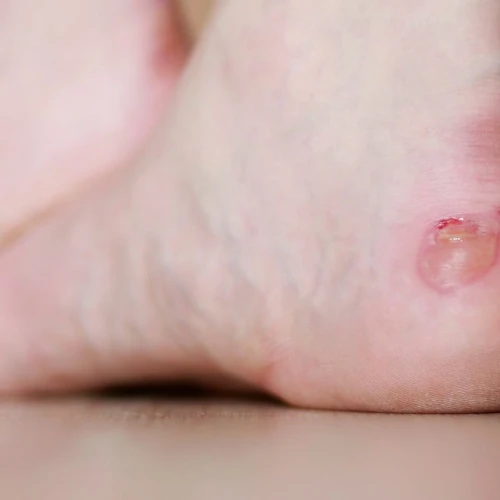What is a blister?1, 2
A blister is defined as the detachment of the upper layer of the skin caused by repeated friction (walking, sport, etc.). It is the skin’s defence mechanism. The skin has three superimposed layers: i.e. the epidermis, which is constantly renewed, the dermis and hypodermis, which is the deepest layer.
If the skin is irritated due to constant rubbing, the epidermis will turn red, and the upper layer of the skin will separate itself from the dermis. This process results in the formation of a small pocket filled with a clear fluid: i.e. the blister. This skin reaction helps protect the injured tissue underneath the blister. A blister, in fact, plays a protective role by preventing pressure on the wound located underneath, and contact with external pathogens. Blisters generally form on the foot, above the heel, which is an area of the skin particularly exposed to the repeated rubbing of shoes and socks.
What are the symptoms of a blister on the foot?1
A blister on the foot can range from the size of a pinhead to a blister measuring 3 cm or more in diameter. It is painful when pressed and the surrounding area can sometimes be red. If a small skin vessel has been damaged following repeated rubbing, the blister may be filled with blood. If the blister is infected, it can contain pus (i.e. thick yellow or green liquid).
How does a foot blister develop?1, 2
A blister develops in three successive phases:
- The skin in the area of the repeated rubbing will turn red;
- A blister (also called a “phlyctena”) filled with clear fluid will appear;
- Blisters can burst spontaneously as a result of the rubbing, and the top layer of the skin will peel off leaving ‘raw’ skin beneath. The area feels like it is burning or stinging and is painful and can become infected in some cases.
- Blisters will dry out and the deeper layer of skin will start the healing and renewal process. This stage generally lasts for around 1-2 weeks.
What can cause a blister on the foot?1
In addition to rubbing, blisters on the foot can appear due to heat and humidity. People who have very sweaty feet are therefore at greater risk of developing blisters.
Other possible causes include:
- Second-degree burns (e.g. burns caused by hot liquids, sunburn, etc.);
- Frostbite to the toes after prolonged exposure to the cold;
- Contact allergy (contact eczema) to a chemical product.
Treatment: how to treat a blister on the foot?2, 3
Foot blisters caused by rubbing must be treated quickly to avoid infection. The treatment will depend on the nature of the blister.
If you notice a simple reddening of the skin around the heel, apply a plaster/dressing to act as a barrier, a sort of “second skin”. This type of plaster is available from chemists and contains hydrocolloids, which are moisture-retentive substances required for healing and providing pain-relief, meaning you can keep walking.
Unbroken and small blisters
If you already have a blister, don’t try to burst it as raw skin acts as a gateway for germs. Use soap and water to clean the blister. Pat the blister dry; don’t rub it. Cover it with a plaster/dressing to protect it but do not press down on it. At night, remove the dressing to allow the blister to dry out.
Avoid the rubbing that caused the blister until it has healed.
Unbroken, large and painful blisters
In such cases, you will need to burst the blister. Follow these steps:
- Wash your hands with soap and water;
- Sterilise a needle with a disinfectant or heat it with a lighter or match;
- Gently pierce the edge of the blister to release the fluid inside;
- Do not tear the dead skin covering the blister, as it acts as a natural dressing that helps the area to heal;
- Disinfect the area with an antiseptic solution before applying a sterile dressing without pressing down on the skin;
- Change the dressing as soon as it becomes moist. At night, sleep without a dressing to allow the blister to dry out.
Blisters that have burst spontaneously with exposed raw skin
Leave the dead skin or remove it using disinfected scissors. Then clean the raw skin with soap and water or an antiseptic solution. After this, apply a hydrocolloid dressing. Change the dressing as soon as it becomes moist. At night, sleep without a dressing to allow the blister to dry out.
Foot blisters: when should you see a doctor?3
You should see a doctor if you show signs of infection:
- The skin around the blister is red, hot to the touch, inflamed and painful;
- There is a discharge of pus;
- You have a temperature.
Caution: a number of factors increase the risk of having an infected blister such as diabetes, peripheral arterial disease of the lower limbs and immuno-depression.
How to prevent a blister on the foot?4
As blisters are most commonly caused by repeated rubbing, the best way to prevent them is to avoid such friction. For this:
- Wear shoes fitted correctly to the shape of your foot and avoid wearing a pair of new shoes for too long.
- Keep your feet as dry as possible. If your feet sweat a lot, change your socks twice a day.
- Regularly inspect the inside of your shoes looking for anything that is out of place, and which could cause abnormal rubbing and hurt you.
- Use the right pair of socks when you do any physical activity.
- If you are diabetic or have peripheral arterial disease affecting your lower limbs, get your feet checked regularly by a pedicurist/podiatrist or your general practitioner.
- Protect your feet in the cold weather.


